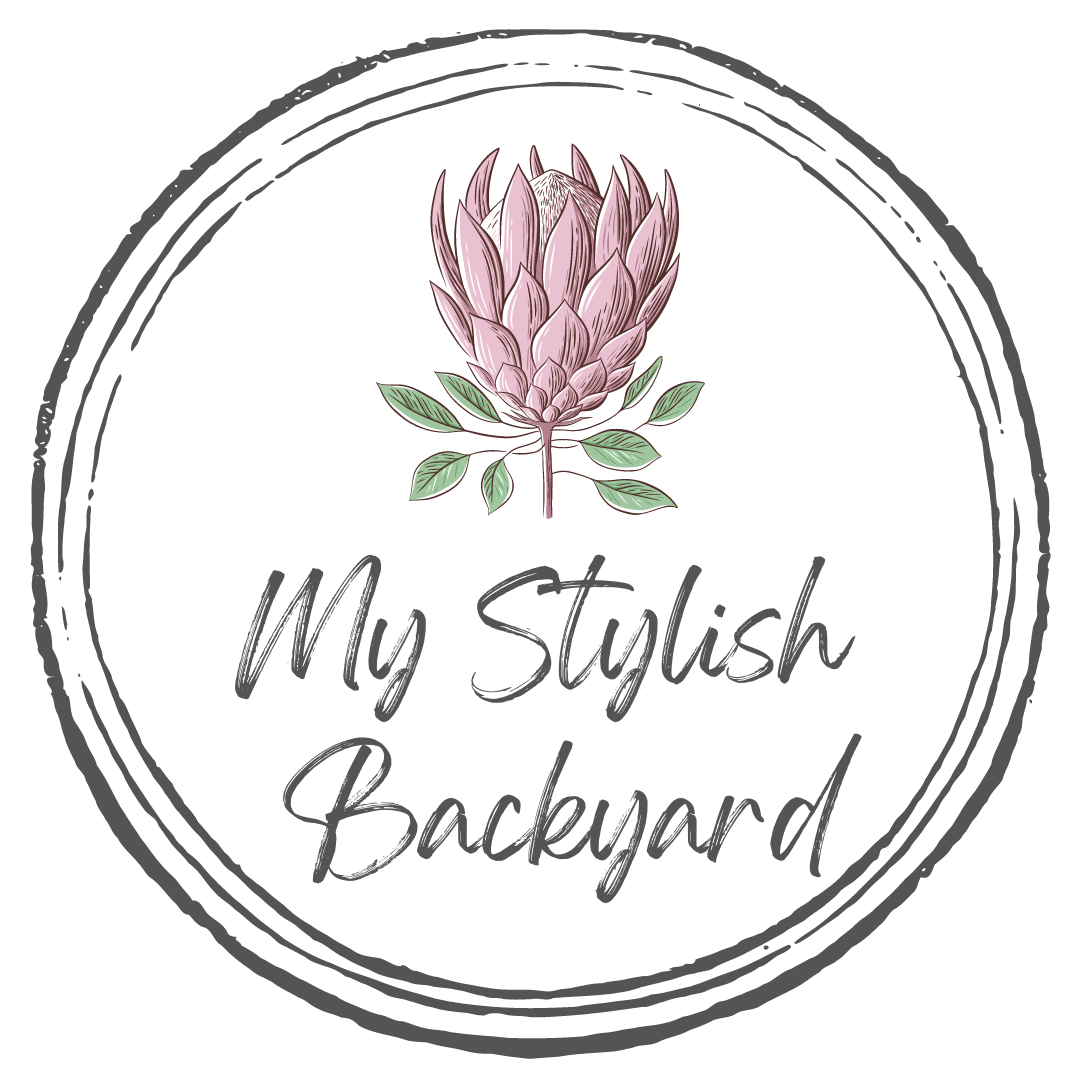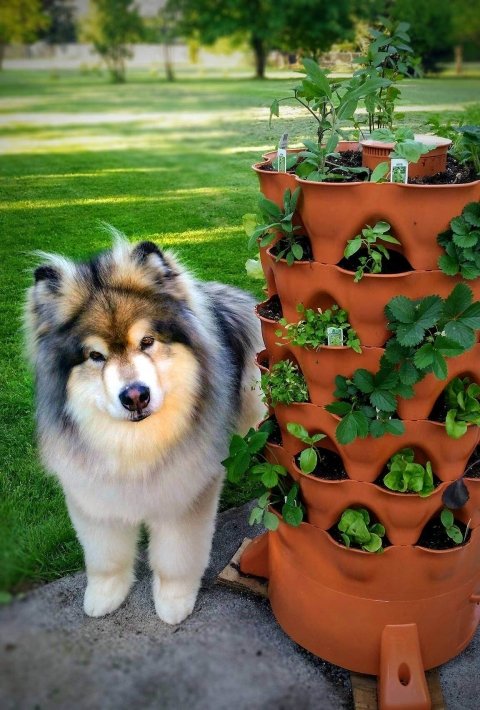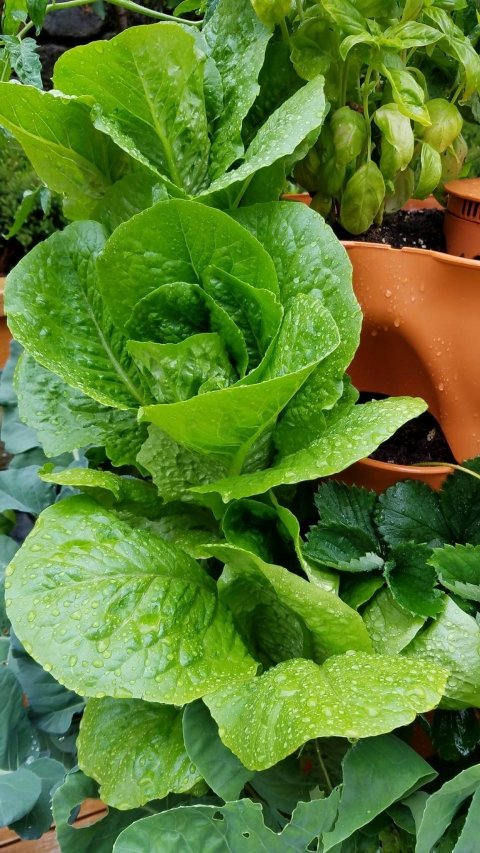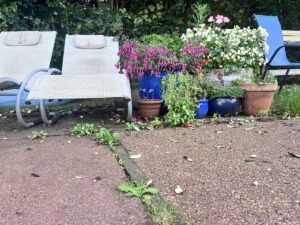Gardening for All: How the Garden Tower Empowers Gardeners with Limited Mobility
Disclosure: This post may contain affiliate links. If you click through and make a purchase, I may earn a small commission at no extra cost to you. As an Amazon Associate, I earn from qualifying purchases. Thank you for supporting My Stylish Backyard.
Gardening is more than just a hobby; it’s a way to connect with nature, find peace, and grow your own food. For many, it brings joy, relaxation, and a sense of accomplishment. However, for those with mobility challenges, such as the elderly, arthritis sufferers, or wheelchair users, traditional gardening methods can be daunting and even painful. The constant bending, kneeling, and reaching can lead to discomfort or even injury.
But what if there was a way to make gardening accessible to everyone, regardless of their physical limitations? Enter the Garden Tower Project – a game-changing solution that’s revolutionizing the way we garden.
The Challenge of Gardening with Limited Mobility
For many gardeners, the joy of tending to plants is often overshadowed by physical challenges:
- Arthritis can make gripping tools painful
- Bending down to plant or weed can be almost impossible for those with back or knee issues
- Wheelchair users or those who find walking difficult may struggle to navigate traditional garden layouts
- Reaching plants at ground level can be a significant challenge
These obstacles don’t mean you have to give up gardening. Instead, you just need the right tools to help you garden smarter, not harder. This is where the Garden Tower Project comes in as a versatile and innovative solution.
Introducing the Garden Tower Project: A Versatile Solution
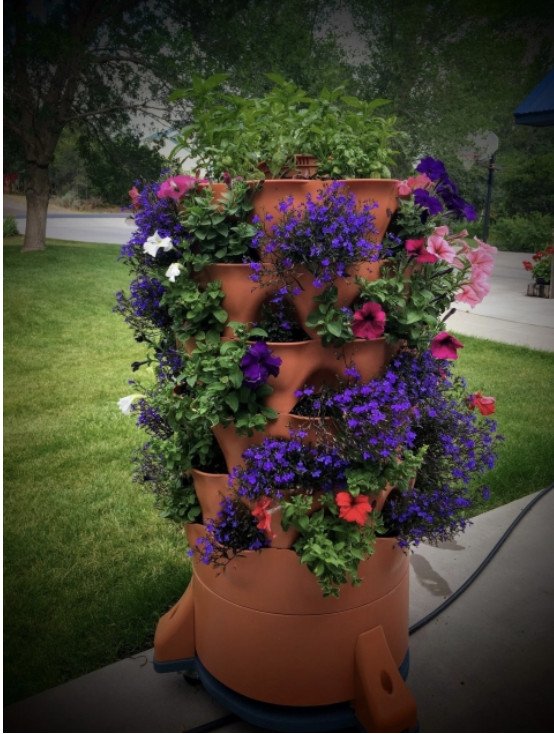
The Garden Tower Project is a unique and innovative gardening system designed to be accessible to everyone. Its compact and vertical design makes it perfect for small spaces, such as patios, balconies, or even indoors. Let’s explore what makes the Garden Tower so special:
- Vertical Design: The Garden Tower allows you to grow up to 50 plants in just four square feet of space. This vertical garden system maximizes your growing area while minimizing the space required.
- 360-Degree Rotation: The tower rotates 360 degrees, enabling easy access to all sides. This feature is particularly beneficial for those with limited mobility, as it brings the plants to you rather than requiring you to move around the garden.
- Elevated Growing: The Garden Tower is raised off the ground, eliminating the need to bend or kneel. This feature is crucial for elderly gardeners, arthritis sufferers, wheelchair users, and those with limited mobility.
- Built-in Composting System: The tower incorporates a central composting column that nourishes your plants naturally while reducing household waste. It’s not just a garden; it’s a sustainable ecosystem.
- Durable Construction: Made from food-grade, BPA-free, UV-stabilized plastic, the Garden Tower is built to last. It withstands the elements, so you won’t have to worry about replacing it every few years.
- Versatility: The Garden Tower can accommodate a wide range of plants, including vegetables, herbs, and even some fruits. This means that gardeners can enjoy a diverse and nutritious harvest right from their own homes.
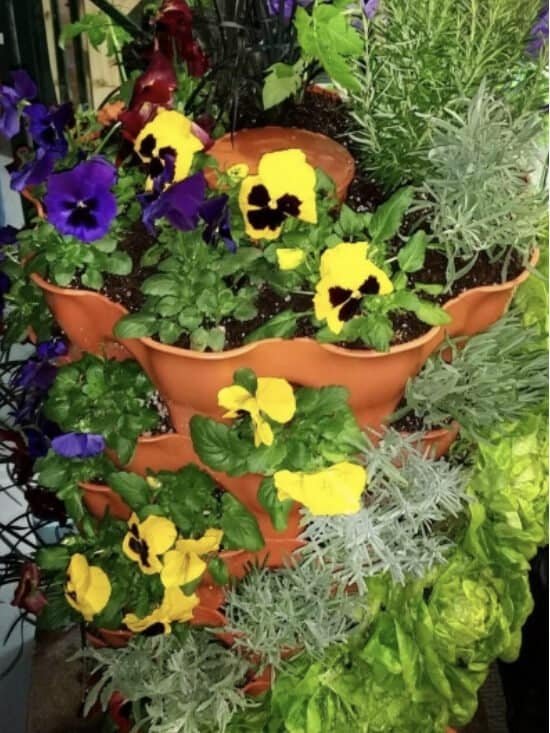
Why the Garden Tower is Perfect for Gardeners with Mobility Issues
Let’s dive deeper into the specific features of the Garden Tower that make it the ideal gardening solution for those with mobility concerns:
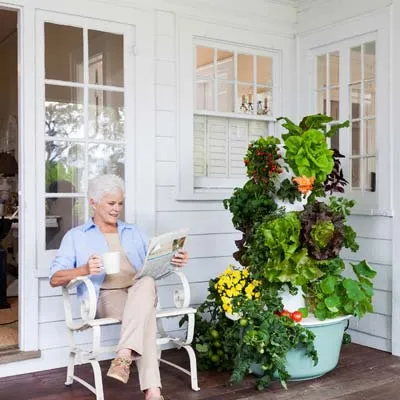
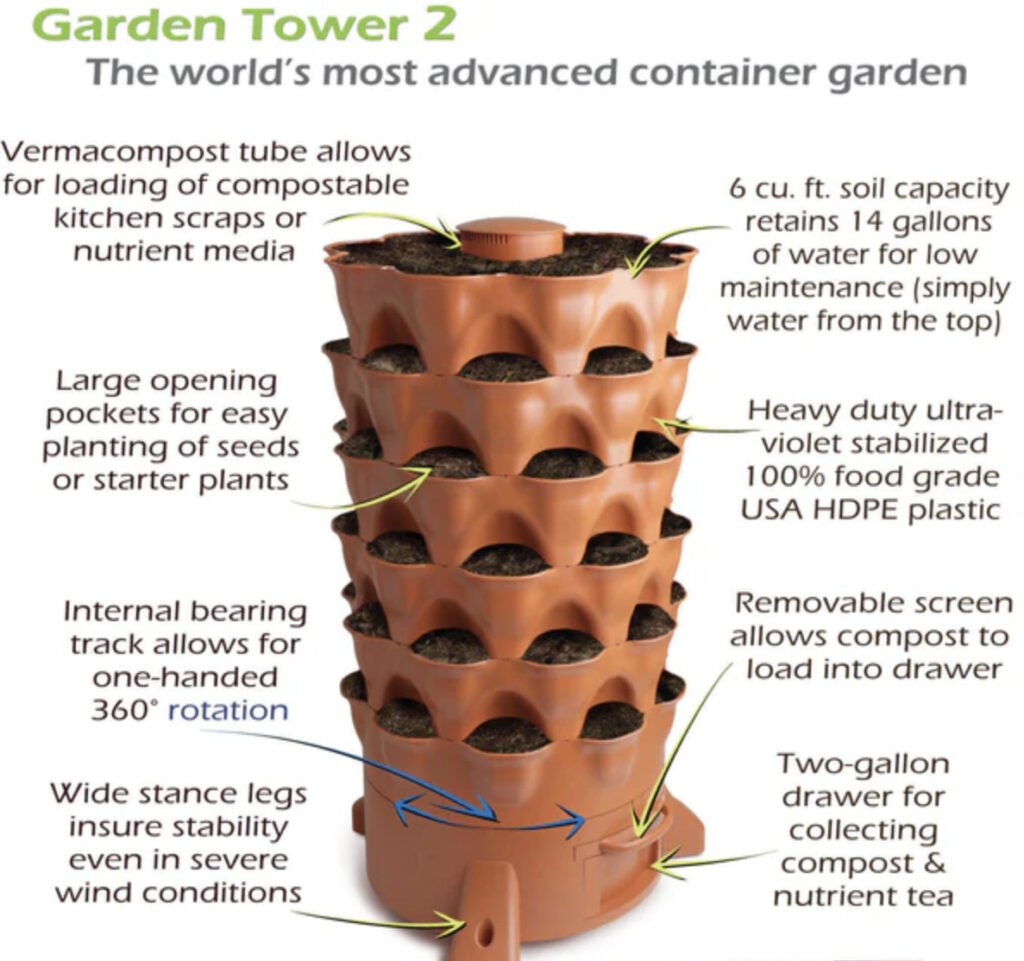
1. Ergonomic Design
The Garden Tower is designed to be used while standing or seated, making it accessible for wheelchair users or those who find bending and kneeling difficult. Its vertical structure means plants are at an easy-to-reach height, and the rotating feature allows access to every plant without straining or moving around.
2. Space-Saving Solution
If space is limited, the Garden Tower is perfect for balconies, patios, or small yards. It can be placed in areas that are easily accessible, reducing the need to navigate uneven ground or large spaces. This feature is particularly beneficial for those living in apartments or with limited outdoor space.
3. Self-Sufficient Watering and Composting System
The Garden Tower’s built-in vermicomposting system naturally fertilizes plants. This means less bending and stooping to fertilize, and less need to purchase and carry heavy bags of compost or fertilizer. The tower’s water-efficient design also reduces the frequency of watering, making maintenance easier for those with limited strength or mobility.
4. Adjustable Height
The tower can be placed on different surfaces or stands to adjust its height, allowing gardeners to find the most comfortable working position for their needs. This customization ensures that the Garden Tower can adapt to various mobility requirements.
5. Health and Wellness Benefits
Gardening has been shown to reduce stress, improve mood, and increase physical activity. For elderly gardeners or those with mobility issues, these benefits are enhanced when gardening becomes easier and more enjoyable with tools like the Garden Tower. It provides a sense of accomplishment and connection to nature that can be incredibly rewarding.
Real Stories from Garden Tower Users
Don’t just take our word for it. Here are some stories from real gardeners who’ve embraced the Garden Tower and experienced its benefits firsthand:
Susan, 72: “I’ve loved gardening my whole life, but as I got older, it became too painful to kneel and bend. The Garden Tower has given me back my passion. I can tend to my herbs and veggies without pain, and the rotating feature is a game-changer!”
Michael, 65: “I have severe arthritis, and traditional gardening was just too hard on my joints. The Garden Tower lets me garden again. I sit in my wheelchair and spin the tower to reach every plant. It’s the best investment I’ve made in years.”
Linda, 58: “Being in a small apartment, I never thought I could have a real garden. The Garden Tower fits perfectly on my balcony, and I can grow everything I need for fresh salads all year round. It’s incredibly convenient and easy to use.”
Getting Started with Your Garden Tower

Ready to make gardening accessible, fun, and productive again? Here’s how to get started with your Garden Tower:
Step 1: Choose Your Location
Select a spot that receives at least 6 hours of sunlight daily. Remember, the beauty of the Garden Tower is that it can be placed on a patio, balcony, or even indoors near a sunny window. If using indoors, ensure you have sufficient natural light or a grow light. Make sure the surface is flat and stable to prevent tipping.
Step 2: Assembly
The Garden Tower comes with clear instructions for easy assembly. If you need assistance, consider asking a family member or friend to help with the initial setup. The durable construction ensures that once it’s set up, you won’t need to worry about frequent maintenance. Follow the simple instructions provided in the package. The modular design means you can snap the pieces together without tools. Ensure the rotating base is securely attached.
Step 3: Add Soil and Compost
Fill the planting pockets with high-quality potting soil or a soil mix suitable for container gardening. Add a mix of kitchen scraps (fruit peels, vegetable scraps, coffee grounds) to the central compost column. Don’t forget to add composting worms or worm castings to the central column to kickstart your composting system
Step 4: Watering and Drainage
Water from the top, allowing moisture to filter down through all levels. Collect excess water from the base tray and reuse to to conserve water. Check moisture levels regularly, especially during hot periods.
Setp 5: Plant Your Favorites
Now comes the fun part! Choose your favorite vegetables, herbs, and flowers to plant in your Garden Tower. Consider a mix of plants with different harvest times for a continuous yield. Some great options include:
1. Easy to Grow Vegetables
One of the greatest advantages of the Garden Tower is its versatility in supporting various crops. For gardeners with mobility challenges, choosing easy-to-grow vegetables can ensure a successful harvest without too much effort. Here are some of the best vegetable options for your Garden Tower:
Leafy Greens: Lettuce, spinach, and Swiss chard are fast-growing, low-maintenance options. They can be harvested multiple times, providing a continuous supply.
Herbs: Basil, mint, parsley, and cilantro grow well in the small pockets of the Garden Tower and can be harvested regularly.
Cherry Tomatoes: These small, sweet tomatoes thrive in vertical spaces, providing a bountiful harvest without needing too much support.
Radishes: One of the quickest vegetables to grow, radishes are perfect for those who want fast results.
Peppers: Compact and colorful, bell peppers and hot peppers both do well in the Garden Tower.
2. Herbs for Continuous Harvesting
Herbs are an excellent choice for any Garden Tower because they are low-maintenance, highly productive, and can be used in various dishes. Some of the most recommended herbs for accessible gardening include:
Basil: Grows quickly and can be harvested frequently.
Thyme and Oregano: These perennial herbs are easy to care for and thrive even with minimal watering.
Chives: Provide a mild onion flavor and can be continuously harvested.
Mint: Grows vigorously but is best planted in a confined space to prevent it from taking over.
3. Flowers for a Pop of Color and Pollinator Attraction
Don’t forget that your Garden Tower can also be used for flowers, which add color and attract beneficial pollinators like bees and butterflies. Some ideal flowers for the Garden Tower include:
Marigolds: Bright, cheerful flowers that also help repel pests.
Nasturtiums: Edible flowers that add color and a peppery flavor to salads.
Petunias: Low-maintenance, long-blooming flowers that add vibrant color.
Alyssum: A beautiful, cascading flower perfect for the lower sections of the tower.
Step 5: Maintain with Ease
Thanks to the Garden Tower’s design, maintenance is a breeze. Water your plants regularly, add kitchen scraps to the compost column, and rotate the tower as needed to ensure all plants receive adequate sunlight.
Tips for Successful Tower Gardening
To make the most out of your Garden Tower, here are a few additional tips:
- Rotate Regularly: Make use of the 360-degree rotating feature to ensure even sunlight exposure and easy access to all your plants. This helps them grow more evenly and reduces the need to reach or strain.
- Keep It Close: Place your Garden Tower in a location that’s easy to reach from your home. Keeping it nearby will encourage you to garden more often.
- Use Organic Materials: The built-in composting system is perfect for kitchen scraps. Use organic materials to keep your plants nourished and your garden sustainable.
- Vertical Trellising: For vining plants like peas or cucumbers, use lightweight trellises attached to the tower for additional support.
- Seasonal Rotation: Plan your planting schedule to enjoy fresh produce year-round, adjusting for your climate.
- Regular Harvesting: Frequent harvesting encourages continued production and keeps your plants manageable.
- Pest Management: Use organic pest control methods to keep your plants healthy without harsh chemicals.
- Take Breaks and Stay Hydrated: Even though the Garden Tower reduces physical strain, remember to take breaks and stay hydrated, especially on hot days. Alway make sure you have a water bottle on you and keep sipping to help yourself stay hydrated
Customize Your Garden Tower Experience
The Garden Tower Project offers various accessories to enhance your gardening experience:
- Casters: Add wheels to your tower for even easier mobility. Buy Now
- Extension Kits: Increase your growing capacity with tower extensions. Buy Now
- Greenhouse Covers: Extend your growing season with protective covers. Buy Now
Conclusion: Embrace the Joy of Gardening with the Garden Tower
Gardening should be a joyful and fulfilling activity for everyone. With the Garden Tower, mobility issues don’t have to stand in the way of cultivating your love for plants, flowers, and fresh food. This innovative vertical gardening solution is specifically designed to make gardening accessible for everyone—whether you’re dealing with arthritis, using a wheelchair, or just looking for an easier way to garden.
The Garden Tower Project is more than just a gardening solution; it’s a gateway to renewed independence, health, and joy for gardeners facing mobility challenges. By combining innovative design with the timeless pleasures of gardening, the Garden Tower opens up a world of possibilities.
Don’t let physical limitations hold you back from the hobby you love. With the Garden Tower, you can continue to nurture plants, grow your own food, and experience the countless benefits of gardening, all from the comfort of your chair or wheelchair.
Remember, gardening is not just about the harvest; it’s about the joy of nurturing life, connecting with nature, and the satisfaction of self-sufficiency. The Garden Tower Project makes all of this accessible to everyone, regardless of age or physical ability.
So why wait? Discover the Garden Tower today and start growing your garden with ease and comfort. Visit the Garden Tower Project website to learn more and start your journey towards accessible gardening. Your future self will thank you as you bite into that first, homegrown tomato or snip fresh herbs for your evening meal.
Start your vertical gardening adventure today and rediscover the pleasures of gardening, one tower at a time!
Buy yours now here!

FAQs About the Garden Tower System for Gardeners with Mobility Challenges
1. How much does a filled Garden Tower weigh, and can it be moved after setup?
A fully assembled Garden Tower 2 filled with soil and plants can weigh between 200-300 pounds, depending on soil moisture levels and plant maturity. While the tower includes wheels on its base, moving a fully loaded tower is not recommended for people with strength limitations. It’s best to position your tower where you want it before filling it with soil. If repositioning becomes necessary, partially emptying the tower first can make moving more manageable.
2. Can I grow root vegetables like carrots and potatoes in a Garden Tower?
Yes, but with some limitations. The planting pockets can accommodate smaller root vegetables like radishes, baby carrots, and fingerling potatoes. However, larger root crops that need significant depth may not develop properly. Focus on varieties specifically bred for container gardening or choose “mini” varieties of root vegetables for best results in the Garden Tower system.
3. How do I handle pest management with limited mobility?
The elevated design of the Garden Tower actually provides natural pest management advantages. Many ground-dwelling pests like slugs and some insects have difficulty reaching plants in the tower. For pests that do appear, consider biological controls like beneficial insects or use spray treatments that can be applied while seated. Neem oil solutions in ready-to-use spray bottles are particularly convenient for gardeners with mobility limitations.
4. What’s the minimum maintenance required to keep a Garden Tower productive?
At minimum, a Garden Tower needs watering every 1-3 days (depending on climate and season), weekly addition of kitchen scraps to the composting column if using that feature, and occasional harvesting of mature plants. For those with significant mobility challenges, adding moisture-retaining materials to your soil mix and installing a simple drip irrigation system can reduce maintenance to harvesting and occasional compost additions, making the system manageable even with limited physical capacity.
5. Can the Garden Tower be used indoors for year-round gardening?
Yes, the Garden Tower can be used indoors with proper lighting. This is particularly beneficial for gardeners with mobility issues in colder climates, as it eliminates the need to navigate outdoor conditions during winter months. When used indoors, the tower requires a location with adequate drainage (like a large drip tray) and supplemental grow lights, as most indoor locations lack sufficient natural light for vegetable production. Without grow lights, the tower can be used indoors for shade-loving ornamental plants but will have limited success with food crops.
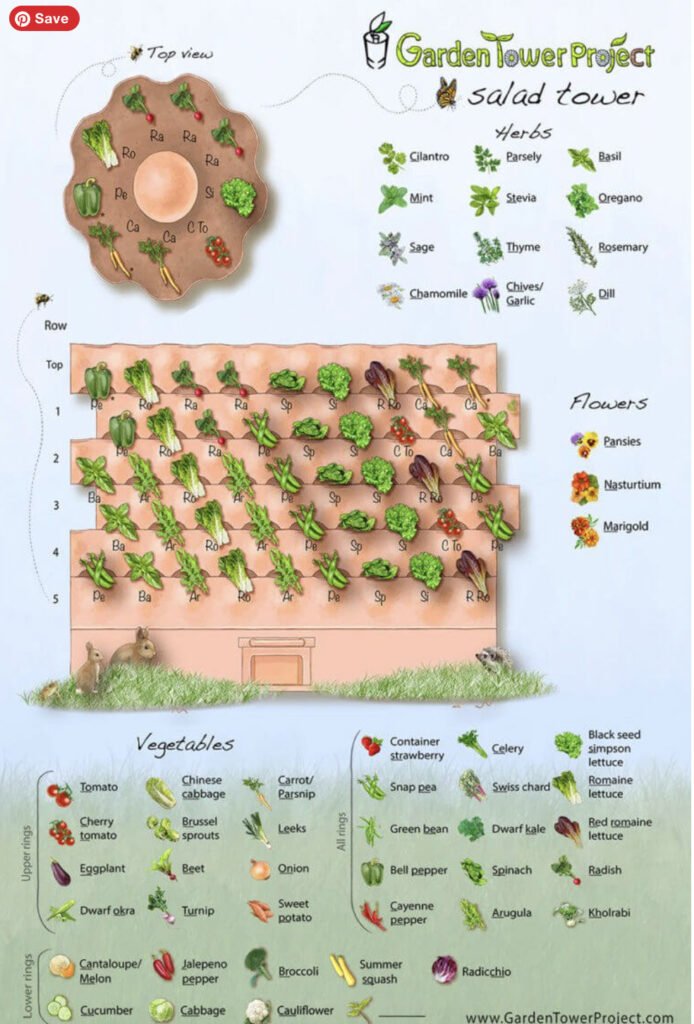
Why Accessibility Matters in Gardening
Gardening isn’t just a hobby—for many, it’s a source of joy, purpose, and connection to the natural world. Research has consistently shown that gardening offers numerous health benefits, including stress reduction, improved mood, and even pain management. For seniors and those with disabilities, these benefits can be particularly impactful. Unfortunately, traditional ground-level gardens present significant barriers for people with mobility challenges. Bending, kneeling, and lifting become increasingly difficult with age or disability. The physical demands of traditional gardening can exacerbate joint pain, limit participation, and eventually lead many passionate gardeners to abandon their beloved hobby. Creating accessible gardening solutions isn’t just about convenience—it’s about preserving independence, maintaining quality of life, and ensuring that the therapeutic benefits of gardening remain available to everyone, regardless of physical ability.
The Garden Tower Project’s Mission
The Garden Tower Project didn’t just set out to create another planter—they wanted to revolutionize how people grow food, especially those facing challenges with conventional gardening methods. Founded with a mission of sustainability and accessibility, the company has focused on creating solutions that make growing food possible for people in diverse circumstances. The project began with a simple question: How can we make gardening more accessible and sustainable for everyone? The answer evolved into the Garden Tower system, which addresses multiple barriers simultaneously—space constraints, soil quality concerns, composting challenges, and importantly, accessibility issues. By creating a vertical system that brings the plants up to the gardener (rather than forcing the gardener down to ground level), the Garden Tower Project has made significant strides in inclusive garden design. Their continuing refinements to the system demonstrate a commitment to addressing the needs of all gardeners, including those with mobility limitations.
